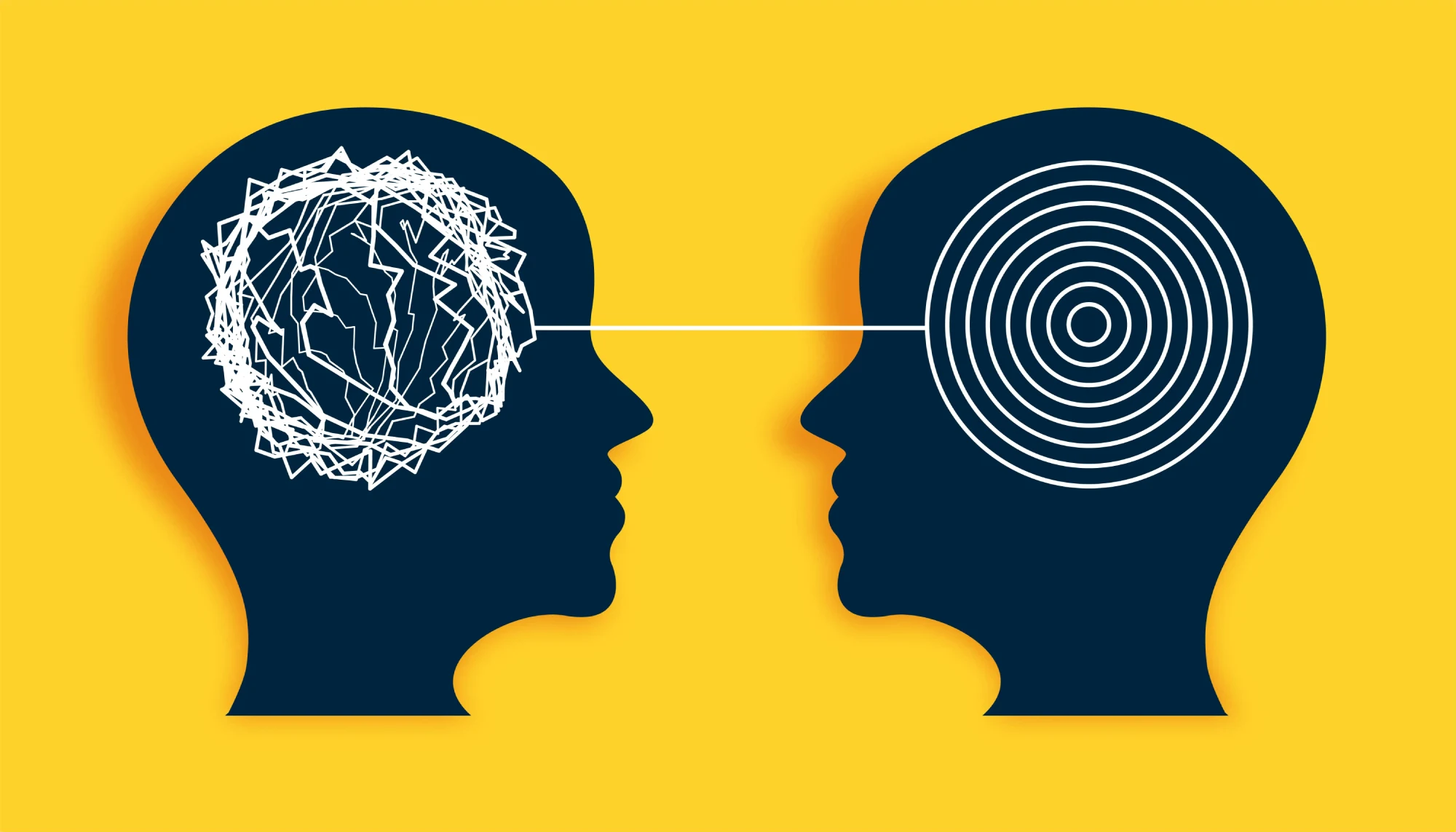
Your Mind’s Two Modes: The Power of Intuitive vs. Analytical Thinking
- Posted by Debayan Sen
- Categories Blogs
- Date September 23, 2025
- Comments 0 comment
Summary : Your mind works in two modes: intuitive (fast, automatic, pattern-based) and analytical (slow, effortful, problem-solving). Both are essential but often clash when overloaded. The key is integration. The Silva Method teaches you to enter the alpha state, where intuition and analysis collaborate. With techniques like the Mental Screen, Three Fingers, and Dynamic Meditation, you can boost decision-making, learning, creativity, and problem-solving. True mastery comes not from choosing one mode, but from training both to work together seamlessly.
Ever notice how you can instantly tell if someone’s having a bad day just by their posture, but calculating a restaurant tip takes actual mental effort? Your mind operates in two distinct modes, and understanding this can change how you approach
everything from work to relationships.
The Coffee Shop Recognition
Picture this: You walk into your favourite coffee shop and immediately spot your friend Sarah across the room. You didn’t scan every face methodically or think “brown hair, blue jacket, sitting by the window.” You just knew it was her in a split second.
Now think about splitting a dinner bill with your 7 friends. Where 3 friends will be paying 15% each and while other 4 will pay rest 55%. And the total bill is $97.58. Suddenly, your mind shifts modes entirely. You might pull out your phone calculator or start doing mental math, feeling that familiar sensation of thinking hard.
These two experiences showcase your mind’s dual operating modes.
The Two Mental Modes
The Intuitive Mind: Your Lightning-Fast Pattern Detector
Your intuitive mind runs constantly in the background, handling tasks with incredible speed and zero conscious effort. It’s like having a super-powered pattern recognition system that:
• Never gets tired – works 24/7 without breaks
• Operates instantly – no loading time required
• Runs automatically – you can’t turn it off even if you wanted to.
This mode excels at:
• Recognizing your mom’s voice on the phone
• Knowing which route to take home
• Sensing tension in a room
• Understanding “How are you?” means more than a medical question
• Stopping at red lights
• Knowing your own phone number
The Analytical Mind: Your Careful Problem Solver
Your analytical mind is more like a high-precision tool that you consciously control. It’s powerful but comes with limitations:
• Requires fuel (mental energy that depletes)
• Needs focus – easily disrupted by distractions
• Works sequentially – can only handle one complex task at a time.
This mode handles:
• Planning your vacation itinerary
• Following a new recipe step-by-step
• Having a difficult conversation with your boss
• Learning to use new software
• Deciding which apartment to rent
• Following GPS directions in an unfamiliar city
The Mental Energy Experiment
Try this right now: What’s 8 × 13?
Notice what just happened in your mind:
• You probably took a slight pause
• Maybe visualized the numbers or broke them down (8 × 10 + 8 × 3)
• Felt a small surge of concentration
• Might have even slightly tensed your facial muscles
That’s your analytical mind firing up. It had to override your intuitive mind’s instant “I don’t know this one” response and engage deliberate calculation.
Your Brain Works Like a Smart Phone
Think of it like your smartphone:
The Intuitive Mind is like all the apps running in the background – checking messages, updating weather, maintaining your connection. You’re not consciously controlling these processes, but they’re constantly working to keep everything smooth
and responsive.
The Analytical Mind is like opening a demanding app – editing a video, playing a graphics-intensive game, or using GPS navigation. Suddenly other functions slow down, your battery drains faster, and the phone might even get warm from the extra processing power required.
When Your Analytical Mind Gets Overloaded
Ever tried to have a serious phone conversation while assembling IKEA furniture? Or attempted to follow complex driving directions while having an argument with your passenger?
That’s what happens when you overload your analytical mind. Unlike your intuitive mind, which can run multiple processes simultaneously, your analytical mind has a strict one-task-at-a-time policy for complex operations.
Signs your analytical mind is maxed out:
• Making silly mistakes on routine tasks
• Feeling mentally drained after concentration-heavy work
• Snapping at people when interrupted during focused work
• Forgetting obvious things when stressed or rushed
The Supermarket Scanner Effect
Here’s a perfect example of the two minds working together: Experienced cashiers can scan and bag groceries while chatting with customers about the weather. The scanning has become an intuitive mind operation through thousands of repetitions, freeing up the analytical mind to handle conversation.
But hand those same items to a new employee on their first day, and suddenly they need complete focus just to find the barcodes. Their analytical mind is fully occupied with what will eventually become automatic.
Practical Applications
Understanding your dual-mode mind can improve daily life:
For Learning New Skills:
• Accept that initial learning requires your analytical mind’s full attention
• Practice until actions become intuitive mind automatic responses
• Don’t multitask while learning something complex
For Important Decisions:
• Recognize when your intuitive mind is making snap judgments
• Deliberately engage your analytical mind for significant choices
• Make important decisions when mentally fresh, not depleted
For Productivity:
• Schedule demanding analytical work during your peak energy hours
• Batch similar tasks to minimize mental switching costs
• Create routines that move repeated tasks from analytical to intuitive processing
For Relationships:
• Remember that first impressions are mostly intuitive mind snap judgments
• Give your analytical mind time to override initial reactions when meeting new
people
• Recognize when stress is making you rely too heavily on intuitive shortcuts
For Creativity:
• Let your intuitive mind generate ideas without immediate analytical judgment
• Use your analytical mind to refine and implement intuitive insights
• Alternate between brainstorming (intuitive) and planning (analytical) phases
Training Your Mental Modes: The Silva Method Approach
Here’s where it gets really interesting: you don’t have to be a passive observer of your mental modes. You can actually train them to work better together using techniques from the Silva Method, a mental training system developed by José Silva.
The Alpha State: Your Gateway to Enhanced Thinking
The Silva Method teaches that your best thinking happens when your brain operates at the “alpha frequency” – a relaxed but alert state that’s perfect for accessing both mental modes simultaneously. Think of it as the sweet spot where your intuitive and analytical minds can collaborate most effectively.
How to Access Your Alpha State:
1. The 3-2-1 Countdown Technique
◦ Find a quiet space and close your eyes
◦ Take three deep breaths
◦ Count slowly from 3 to 1, imagining yourself going deeper into relaxation with each number
◦ Tell yourself: “I am now at my perfect level of mind for enhanced thinking”
2. The Silva Relaxation Exercise
◦ Relax your body completely, starting from your toes up to your head
◦ Imagine a peaceful place (beach, forest, garden)
◦ Spend 2-3 minutes in this mental sanctuary
◦ This primes both your intuitive and analytical modes to work together
Silva Techniques for Each Mental Mode
For Enhancing Your Intuitive Mind:
The Mental Screen Technique:
• In your alpha state, imagine a large mental screen in front of you
• Project your problem or question onto this screen
• Don’t analyze – just observe what images, feelings, or insights arise
• Your intuitive mind will often provide solutions in symbolic or visual form
The Three Fingers Technique:
• While relaxed, press your thumb to your first two fingers
• Program yourself: “Whenever I join these three fingers, I will instantly access
my intuitive insights”
• Practice this during successful intuitive moments to strengthen the association
• Use it during the day when you need quick intuitive guidance
For Supercharging Your Analytical Mind:
The Mental Workshop:
• Create an imaginary workshop in your mind with all the tools you need
• When facing complex problems, visit this workshop in alpha state
• Methodically work through solutions using your mental tools
• Your analytical mind operates more efficiently in this focused, distraction-free environment
The Silva Problem-Solving Formula:
1. Enter alpha state
2. Clearly define your problem
3. Analyze all known factors
4. Declare your intention to find the solution
5. Let go and trust that the answer will come
6. Return to beta (normal waking consciousness) and take action
The Ultimate Integration: The Silva Dynamic Meditation
This powerful technique trains both mental modes to work as a team:
Morning Programming (15 minutes):
• Enter alpha state using the 3-2-1 technique
• Review your day ahead using your analytical mind (schedule, priorities, challenges)
• Then engage your intuitive mind: “Show me insights I need for today”
• End with: “I will function at my optimum level today, using both my intuitive and analytical abilities perfectly”
Evening Review (10 minutes):
• Return to alpha state
• Analytically review what worked and what didn’t
• Intuitively feel what you learned and how you grew
• Program tomorrow’s improvements: “Tomorrow I will be even better at…”
Real-World Silva Applications
For Decision-Making: Use the “Glass of Water” technique – before sleep, drink half a glass of water while programming: “This is all I need to do to find the right solution to [specific problem].” Finish the water upon waking. Your intuitive mind works on
solutions while you sleep, and your analytical mind can evaluate them clearly in the morning.
For Learning: The “Mirror of the Mind” technique helps transfer information from analytical learning to intuitive knowing. Visualize two mirrors – in the left one, see your current skill level; in the right one, see yourself as already mastered. Your mind bridges the gap through practice guided by both modes.
For Creativity: Use the “Laboratory” technique – create a mental space where you can meet with imaginary counselors (historical figures, experts, mentors). Your analytical mind provides the framework and questions; your intuitive mind channels insights through these helpful personas.
The Partnership Perspective
Neither mode is “better” – they’re designed to work as a team, and the Silva Method shows you how to be the conductor of this mental orchestra. Your intuitive mind handles the routine and generates quick insights, while your analytical mind tackles complex challenges and evaluates solutions.
The magic happens when you understand which mode you’re using and can consciously access the right tool for the job. Sometimes you need your intuitive mind’s lightning-fast pattern recognition. Sometimes you need your analytical mind’s
careful reasoning. And sometimes – through Silva techniques – you can use both simultaneously for breakthrough thinking.
Trust your intuitive mind for familiar situations, relationship dynamics, and creative breakthroughs.
Engage your analytical mind for complex problems, important decisions, and learning new skills.
Use Silva Method techniques to train both modes and access enhanced states where they work together seamlessly.
Whether it’s sliding into a parking spot or solving a tough problem, you’ll see which part of your mind is in charge — and how to make both work for you.
You may also like

The Eternal Human Dilemma: Material vs Spiritual

How to Focus on the Present Moment Instead of Problems?

